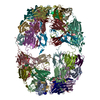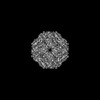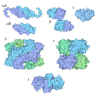+ Open data
Open data
- Basic information
Basic information
| Entry | Database: PDB / ID: 9nvc | ||||||||||||||||||||||||
|---|---|---|---|---|---|---|---|---|---|---|---|---|---|---|---|---|---|---|---|---|---|---|---|---|---|
| Title | mjHSP16.5 24mer (+lysozyme, 75C) | ||||||||||||||||||||||||
 Components Components | Small heat shock protein HSP16.5 | ||||||||||||||||||||||||
 Keywords Keywords | CHAPERONE / sHSP / thermophile / holdase | ||||||||||||||||||||||||
| Function / homology |  Function and homology information Function and homology informationprotein complex oligomerization / response to salt stress / protein folding chaperone / response to hydrogen peroxide / unfolded protein binding / protein folding / response to heat / protein stabilization / protein-containing complex / identical protein binding / cytoplasm Similarity search - Function | ||||||||||||||||||||||||
| Biological species |   Methanocaldococcus jannaschii (archaea) Methanocaldococcus jannaschii (archaea) | ||||||||||||||||||||||||
| Method | ELECTRON MICROSCOPY / single particle reconstruction / cryo EM / Resolution: 2.6 Å | ||||||||||||||||||||||||
 Authors Authors | Miller, A.P. / Reichow, S.L. | ||||||||||||||||||||||||
| Funding support |  United States, 1items United States, 1items
| ||||||||||||||||||||||||
 Citation Citation |  Journal: Nat Commun / Year: 2025 Journal: Nat Commun / Year: 2025Title: Mechanism of small heat shock protein client sequestration and induced polydispersity. Authors: Adam P Miller / Steve L Reichow /  Abstract: Small heat shock proteins (sHSPs) act as first responders during cellular stress, sequestering destabilized proteins (clients) to prevent aggregation and facilitate refolding or degradation. This ...Small heat shock proteins (sHSPs) act as first responders during cellular stress, sequestering destabilized proteins (clients) to prevent aggregation and facilitate refolding or degradation. This critical function, conserved across all life, is linked to proteostasis and protein misfolding diseases. However, the extreme molecular plasticity of sHSP/client complexes has limited mechanistic understanding. Here, we present high-resolution cryo-EM structures of Methanocaldococcus jannaschii sHSP (mjHSP16.5) in apo and multiple client-bound states. The ensemble reveals molecular mechanisms of client sequestration, highlighting cooperative chaperone-client interactions. Client engagement polarizes scaffold stability, promoting higher-order assembly and enhanced sequestration. Higher-order states suggest multiple sHSP/client assembly pathways, including subunit insertion at destabilized geometrical features. These findings provide critical insights into sHSP chaperone function and the interplay between polydispersity and client handling under stress. | ||||||||||||||||||||||||
| History |
|
- Structure visualization
Structure visualization
| Structure viewer | Molecule:  Molmil Molmil Jmol/JSmol Jmol/JSmol |
|---|
- Downloads & links
Downloads & links
- Download
Download
| PDBx/mmCIF format |  9nvc.cif.gz 9nvc.cif.gz | 545 KB | Display |  PDBx/mmCIF format PDBx/mmCIF format |
|---|---|---|---|---|
| PDB format |  pdb9nvc.ent.gz pdb9nvc.ent.gz | 452.8 KB | Display |  PDB format PDB format |
| PDBx/mmJSON format |  9nvc.json.gz 9nvc.json.gz | Tree view |  PDBx/mmJSON format PDBx/mmJSON format | |
| Others |  Other downloads Other downloads |
-Validation report
| Summary document |  9nvc_validation.pdf.gz 9nvc_validation.pdf.gz | 1.3 MB | Display |  wwPDB validaton report wwPDB validaton report |
|---|---|---|---|---|
| Full document |  9nvc_full_validation.pdf.gz 9nvc_full_validation.pdf.gz | 1.3 MB | Display | |
| Data in XML |  9nvc_validation.xml.gz 9nvc_validation.xml.gz | 68.1 KB | Display | |
| Data in CIF |  9nvc_validation.cif.gz 9nvc_validation.cif.gz | 113.5 KB | Display | |
| Arichive directory |  https://data.pdbj.org/pub/pdb/validation_reports/nv/9nvc https://data.pdbj.org/pub/pdb/validation_reports/nv/9nvc ftp://data.pdbj.org/pub/pdb/validation_reports/nv/9nvc ftp://data.pdbj.org/pub/pdb/validation_reports/nv/9nvc | HTTPS FTP |
-Related structure data
| Related structure data |  49832MC  9nv4C  9nv7C  9nv8C  9nvfC  9nviC  9nvjC  9nvkC M: map data used to model this data C: citing same article ( |
|---|---|
| Similar structure data | Similarity search - Function & homology  F&H Search F&H Search |
- Links
Links
- Assembly
Assembly
| Deposited unit | 
|
|---|---|
| 1 |
|
- Components
Components
| #1: Protein | Mass: 16469.990 Da / Num. of mol.: 24 Source method: isolated from a genetically manipulated source Source: (gene. exp.)   Methanocaldococcus jannaschii (archaea) Methanocaldococcus jannaschii (archaea)Gene: MJ0285 / Production host:  Has protein modification | N | |
|---|
-Experimental details
-Experiment
| Experiment | Method: ELECTRON MICROSCOPY |
|---|---|
| EM experiment | Aggregation state: PARTICLE / 3D reconstruction method: single particle reconstruction |
- Sample preparation
Sample preparation
| Component | Name: mjHSP16.5 24mer / Type: COMPLEX / Entity ID: all / Source: RECOMBINANT |
|---|---|
| Source (natural) | Organism:   Methanocaldococcus jannaschii (archaea) Methanocaldococcus jannaschii (archaea) |
| Source (recombinant) | Organism:  |
| Buffer solution | pH: 7.4 |
| Specimen | Embedding applied: NO / Shadowing applied: NO / Staining applied: NO / Vitrification applied: YES |
| Vitrification | Cryogen name: ETHANE |
- Electron microscopy imaging
Electron microscopy imaging
| Experimental equipment |  Model: Titan Krios / Image courtesy: FEI Company |
|---|---|
| Microscopy | Model: TFS KRIOS |
| Electron gun | Electron source:  FIELD EMISSION GUN / Accelerating voltage: 300 kV / Illumination mode: SPOT SCAN FIELD EMISSION GUN / Accelerating voltage: 300 kV / Illumination mode: SPOT SCAN |
| Electron lens | Mode: BRIGHT FIELD / Nominal defocus max: 4000 nm / Nominal defocus min: 1500 nm |
| Image recording | Electron dose: 50 e/Å2 / Film or detector model: GATAN K3 BIOCONTINUUM (6k x 4k) |
- Processing
Processing
| EM software | Name: PHENIX / Version: 1.20.1_4487 / Category: model refinement | ||||||||||||||||||||||||
|---|---|---|---|---|---|---|---|---|---|---|---|---|---|---|---|---|---|---|---|---|---|---|---|---|---|
| CTF correction | Type: PHASE FLIPPING AND AMPLITUDE CORRECTION | ||||||||||||||||||||||||
| 3D reconstruction | Resolution: 2.6 Å / Resolution method: FSC 0.143 CUT-OFF / Num. of particles: 780906 / Symmetry type: POINT | ||||||||||||||||||||||||
| Refinement | Highest resolution: 2.6 Å Stereochemistry target values: REAL-SPACE (WEIGHTED MAP SUM AT ATOM CENTERS) | ||||||||||||||||||||||||
| Refine LS restraints |
|
 Movie
Movie Controller
Controller










 PDBj
PDBj


